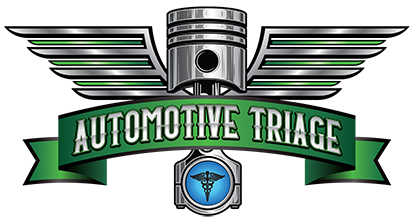OUR STANCE
Automotive Triage employs a talented team of certified technicians with the ability to provide multiple services to accommodate our customer needs. Our highly skilled technicians are qualified to perform quality repairs on nearly all make and model vehicles. The Automotive Triage facilities are equipped with the latest technology and training to accommodate the repair needs in the constantly changing automotive industry.
Our management team sets the standards with our “AT Standard Operating Procedures” and our technicians perform accordingly. Through each step of the repair process, management has integrated a Quality Control process to ensure work is being completed per specifications and as promised. At Automotive Triage, we understand each customer is different and their needs may vary but our commitment to integrity, safety and customer service will never waiver.
TRIAGE SERVICES
MAINTENANCE
OIL & FILTER CHANGE
The most common routine maintenance for your vehicle is the oil and oil filter change. Your vehicles are one of your biggest investments. It is in your best interest to maintain them properly. However, an oil change should be quick, economical and it should not be a hassle for the customer. The Automotive Triage technicians will complete your oil changes efficiently, complete an 18-point inspection on your vehicle, and the service writer will provide you with documentation. Our management group emphasizes the importance of not pressuring our customers or wasting their time and only suggesting repairs or maintenance that is necessary.
Here are the services we provide during your oil change service:
- We will remove and replace your vehicle’s motor oil using only the best brands of full synthetic oil, synthetic blend oil or high mileage oil, depending on your vehicle specifications.
- We will replace your vehicle’s oil filter with the filter specified.
- We will complete an 18-point inspection of your vehicle
- We will provide you with your inspection document, discuss any future needs, and thank you for your business.
Here are the services our technicians will perform during the 18-point inspection:
- Check Brake Fluid
- Check Power Steering Fluid
- Check Windshield Washer Fluid
- Inspect the battery (s)
- Check the Coolant Reservoir
- Inspect the Suspension Components
- Inspect the Belts
- Check the Cabin Air Filter
- Check the Engine Air Filter
- Inspect the Wiper Blades
- Inspect and Check the Tire Wear
- Inspect all Lights
- Check the vehicle for Leaks
- Check the Horn
- Check the Transmission Fluid (if dipstick accessible)
- Inspect Front/Rear Differential
- Inspect Transfer Case
- Reset Oil Monitor Light
TUNE UPS
A vehicle Tune-Up is one of the more common terms customers hear when discussing vehicle maintenance. Every vehicle manufacturer has a suggested, routine maintenance schedule outlined for each vehicle. You can access that schedule from the vehicles Owner’s Manual or on-line. Some of those routine items include services that help maintain your vehicle’s power, efficiency and performance. Those services are usually the ones classified as a Tune-Up.
Automotive Triage understands that in order for your vehicle to get the best gas mileage and engine performance, it must have sparks plugs in good condition, clean air filters, clean fuel filters, and clean fuel injectors. If you get Tune-Ups based on your vehicle manufacturer’s recommendations, you are investing in the long-term health of your vehicle that will ultimately save you time and money.
Here are items offered during a Tune-Up at Automotive Triage:
- Comprehensive inspection of the engine components
- Remove and replace spark plugs
- Timing and idle setting (if applicable to your vehicle)
- Fuel Filter Replacement
- Air Filter Replacement
- Fuel System Cleaning Service
BRAKE SERVICES
Automotive Triage understands that if your brakes are not functioning properly, then you, your passengers, and other drivers on the road run the risk of an accident. We feel so strongly about our customer’s safety that we offer free brake system inspections. If you are in need of a brake service and inspection, look no further than the Automotive Triage, where we offer free brake inspections year-round.
Our inspections include:
- Measurement of front and rear brake pad wear
- Measurement of rotor wear
- Measurement of drum wear
- Brake fluid test
- Parking/emergency brake inspection
Common brake warning signs:
- Squealing/grinding noise when applying brakes
- Vibration when applying brakes
- Brake pedal goes down too far
- Brake pedal feels spongy or soft
- Brake pedal is very hard
- Dash brake light is ‘on’
- Brake fluid is low
Our brake services include:
- Remove and replace brake pads with new quality pads
- Remove and replace brake shoes with new quality shoes
- Machining or turning of rotors and drums
- Anti-lock brake diagnostics
- Repacking of wheel bearings
- Replacement of seals
- Lubricating critical wear items
- Brake fluid exchange / bleeding lines (removes brake fluid contaminants and air)
- Brake calipers and/or wheel cylinders installed
- Lifetime warranty on labor*
- 12,000-mile/12-month warranty on drums and rotors*
- Inspecting/adjusting parking brake
- Many more adjustments, as needed
ALIGNMENTS
Tire alignment, also known as wheel alignment, can help your tires perform properly and help them last longer. It can also improve handling and keep your vehicle from pulling in one direction or vibrating strangely on the road.
What is Tire Alignment?
Alignment refers to an adjustment of a vehicle’s suspension – the system that connects a vehicle to its wheels. It is not an adjustment of the tires or wheels themselves. The key to proper alignment is adjusting the angles of the tires which affects how they make contact with the road.
How Do I Know if I Need a Tire Alignment?
There are a couple ways to tell if your car needs a tire alignment. If you’ve noticed one or more of these indicators, you should have your alignment checked by a licensed service technician immediately.
- Uneven tread wear
- Vehicle pulling to the left or right
- Your steering wheel is off center when driving straight
- Steering wheel vibration
Camber, Toe, & Caster
When a technician checks your tire alignment, he or she is mainly concerned with three things:
- Camber
This is the inward or outward angle of the tire when viewed from the front of the vehicle. Too much inward or outward tilt, also known as negative and positive camber, respectively, indicates improper alignment and will need to be adjusted. Worn bearings, ball joints, and other wheel-suspension parts may contribute to camber misalignment.
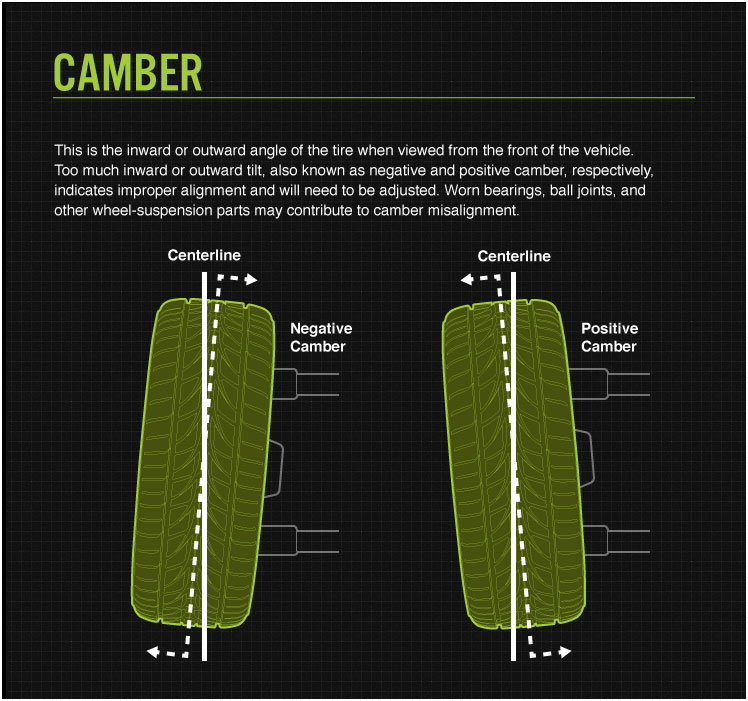
- Toe
Distinct from camber alignment, toe alignment is the extent to which your tires turn inward or outward when viewed from above. If that’s confusing, just stand up and look down at your feet. Angle them inward toward the center of your body. When the tires on your car are angled the same way (remember, we’re thinking in terms of birds-eye-view), we call this toe-in alignment. Angle your feet outward and you have toe-out alignment. Both require adjustment.
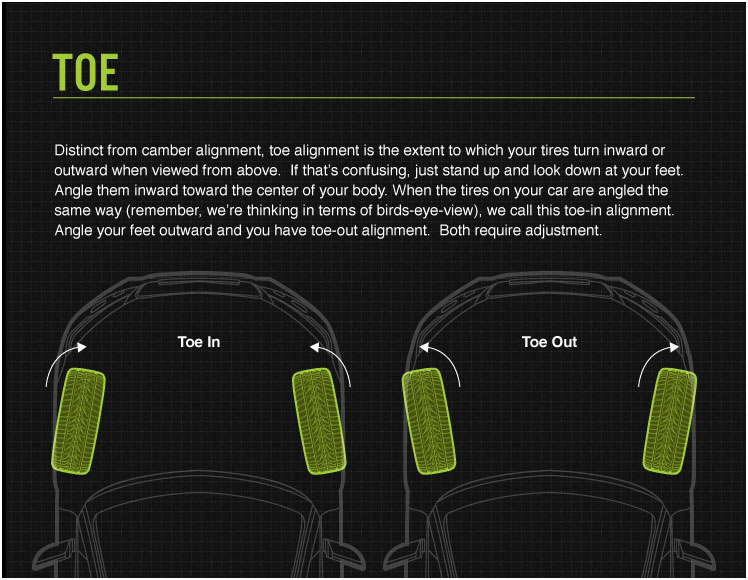
- Caster
Your caster angle helps balance steering, stability, and cornering. Specifically, it’s the angle of your steering axis when viewed from the side of your vehicle. If you have positive caster, the steering axis will tilt toward the driver. Negative caster, on the other hand, means the steering axis tilts toward the front of your vehicle.

Why Tire Alignment Matters
Improper wheel or tire alignment can cause your tires to wear unevenly and prematurely. Here are some specific types of undue tread wear attributable to misalignment:
Feathering
Tires are “feathered” when the tread is smooth on one side and sharp on another. This is usually a sign of poor toe alignment.
Camber wear
This strain of tread wear means the inside or outside of the tread is significantly more worn than the center of the tread. As its name implies, positive or negative camber causes this type of wear.
Heel/toe wear
This happens when one side of your tread blocks wears down more quickly than the other in a circumferential direction. When you run your hand over the tread, it will look and feel like saw teeth when viewed from the side. Heel/toe wear could be a sign of under inflation and/or lack of rotation.
If you’re experiencing any of these unusual wear patterns, you should have a technician check your alignment. While tire wear prevention is a good reason to keep your wheel alignment in check, the consequences of misalignment can also play out in overall vehicle performance. A car that pulls to one side or steers erratically, for example, probably has an alignment problem.
TIRE ROTATION
Tire Rotation is the practice of moving the wheels and tires of an automobile from one position to another, to ensure even tire wear. Even tire wear is desirable to extend the useful life of a set of tires.
The weight on the front and rear axles differs which causes uneven wear. With the majority of cars having the engine in front, the front tires typically bear more weight than the rear tires. Front-wheel drive vehicles have not only the engine but also the transaxle in front, adding to the weight difference. Moreover, additional stress is placed disproportionately on the front tires by braking and steering.Thus, tire rotation needs to occur more frequently for front-wheel drive vehicles.
Turning the vehicle also causes uneven tire wear. The outside, front tire is worn disproportionately. In countries with right-hand traffic, for example, right turns are tighter than left turns and most cloverleaf interchanges and parking ramps are right-hand curves, so the left front tire wears faster than the right front, because the left tire travels a greater distance around those turns and a majority of turns will be to the right. Conversely, the sidewalls on the right tire tends to be bumped and rubbed against the curb while parking the vehicle, causing asymmetric sidewall wear. The symmetric opposite occurs in countries that drive on the left.
In addition, mechanical problems in the vehicle may cause uneven tire wear. Wheels misaligned with each other and/or with the vehicle’s axis will tend to be dragged along by the other wheels, causing uneven wear in that tire. If the alignment is such that the vehicle tends to turn, the driver will correct by steering against the tendency. In effect the vehicle is constantly turning, causing uneven tire wear.
Car manufacturers will recommend tire rotation frequency and pattern. Tire rotation is often recommended every 5,000 mi to 8,000 mi, however this will differ between tire manufacturers and car makes. The rotation pattern is typically moving the back wheels to the front, and the front to the back, but crossing them when moving to the back.If the tires are unidirectional, the rotation can only be rotated front to back on the same side of the vehicle to preserve the rotational direction of the tires. Most unidirectional tires can be moved from side to side if they are remounted; tires with asymmetric rims are a rare exception.More complex rotation patterns are required if the vehicle has a full-size spare tire that is part of the rotation, or if there are snow tires.
Four (4) Tire Rotation
What tire rotation pattern should be followed? The Tire & Rim Association has identified three traditional rotation patterns covering most vehicles (equipped with non-directional tires and wheels which are the same size and offset). The first being the “Rearward Cross” (Figure A); the second being the “Forward Cross” (Figure C); and the third is the “X-Pattern” (Figure B). The X-Pattern can be used as an alternative to A or C.
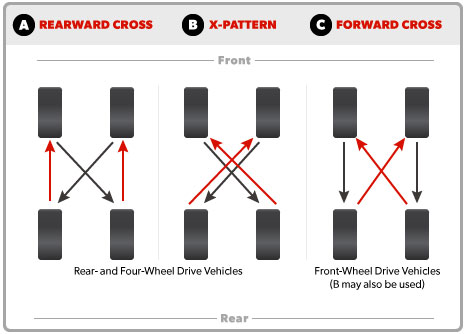
Today’s performance tire and wheel trends have provided the need for two additional tire rotation patterns.
- The “Front-to-Rear” (Figure D) pattern may be used for vehicles equipped with the same size directional wheels and/or directional tires.
- A “Side-to-Side” (Figure E) pattern may be used for vehicles equipped with different sized non-directional tires and wheels on the front axle compared to the rear axle.

If the last two rotation patterns do not provide even wear, dismounting, mounting and re-balancing will be necessary to rotate the tires.
Vehicles that use different sized directional wheels and tires, and/or wheels with different front and rear offsets with directional tires will require dismounting, mounting and re-balancing to rotate tires.
Five (5) Tire Rotation
While many vehicles are equipped with temporary spares that cannot be included in a tire rotation program, if the vehicle’s four wheels and tires on the ground match the spare wheel and tire (if non-directional and not branded “for temporary use”), they should be included in the tire rotation pattern. Follow the vehicle manufacturer’s recommended tire rotation procedures, or if not available, insert the spare in the right rear position at every rotation. Place the tire that would have gone to the right rear in the trunk as the spare until the next tire rotation.
- On front-wheel drive cars with full-size matching spare, rotate the tires in a forward cross pattern (Figure F)
- On rear-wheel or four-wheel drive cars with full-size matching spare, rotate the tires in a rearward cross pattern (Figure G)
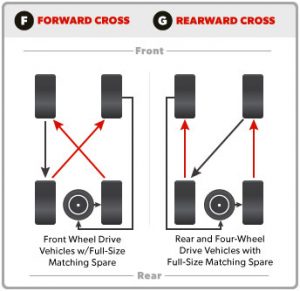
Five tire rotation results in equally distributed use that will help maintain equivalent tread depths on all five tires throughout their life. When applied to many four-wheel drive and all-wheel drive vehicles, this is required to prevent driveline damage if a flat tire forces a new spare to be put into service with partially worn tires on the other three wheel positions.
Six (6) Tire Rotation
Vehicles with dual rear wheels and non-directional tires of the same type and size in all six wheel positions may use either of the following rotation patterns (Figure H and Figure I), keeping in mind the wear pattern and wear rate of dual rears are sensitive to significant differences in tread depth within the pair. If the vehicle has tires of a different type and/or size on the front and rear axles, they should only use the rotation pattern depicted in Figure I, rotating across the axle side-to-side, but not front-to-rear.
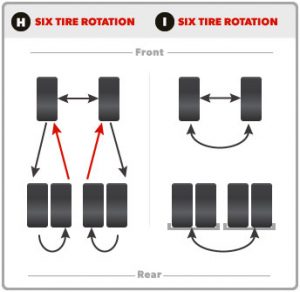
Studded Winter / Snow Tire Rotation
In order to achieve the best possible wintertime performance and longest lifetime from a set of studded tires, they should be rotated periodically to equally share the vehicle’s workload. Tire rotation will help all four tires maintain equivalent tire wear throughout their life in spite of the different driving demands experienced on a vehicle’s steering and non-steering positions, as well as its driven vs. non-driven axles. The resulting equivalent tread depths will help balance traction levels and handling characteristics, as well as help drivers get more life out of their set of four tires.
Tire Rack recommends rotating studded tires at the beginning of every winter season or every 4,000 miles, whichever comes first.
The rolling direction of studded tires should never be changed.
This can be achieved by rotating tires from front to rear on the same side of the vehicle.
It is also permitted to remount the tires inside-out on the wheels to allow them to be used on other side of the vehicle if uneven wear due to camber is detected.
NC SAFETY & EMISSIONS INSPECTION
Automotive Triage is a certified North Carolina Inspection station. We have certified technicians on-site with the ability to perform both Safety and Emissions Inspections. Please visit one of our locations when it is time for your inspection.
The information below is from the NCDMV website:
Emissions & Safety Inspections
A motor vehicle must pass an annual safety inspection before it can be registered in North Carolina or the registration can be renewed. The inspection must be completed within 90 days of renewing the vehicle.
During a safety inspection, a licensed mechanic examines a vehicle’s headlights, signals, brakes, steering, windows and tires.
Motor vehicles registered in 22 North Carolina counties must also pass an emissions inspection, which is conducted at the same time as the safety inspection.
Failure to get a vehicle inspected by the due date will result in a vehicle’s registration being blocked until the vehicle is inspected.
Safety Inspections
A motor vehicle registered in North Carolina must pass an annual safety inspection before its registered owner can renew its vehicle registration. They can be conducted no more than 90 days before the license plate and registration expires. During a safety inspection, a licensed mechanic examines a vehicle’s:
- Headlights
- Accessory lights
- Directional signals
- Foot brake
- Parking brake
- Steering
- Windshield wipers
- Tinted windows, if applicable
Motor vehicles registered in 22 North Carolina counties must also pass an emissions inspection, conducted at the same time as the safety inspection.
Failure to get a vehicle inspected by the due date will result in a vehicle’s registration being blocked until the vehicle is inspected.
Exemptions
Vehicles more than 35 years old are exempt from the annual safety inspection.
Fees
| Safety inspection | $13.60 |
| On-board diagnostic emissions inspection | $30 |
| Tinted window inspection | $10 |
Failure to Pass Inspection
A vehicle that passes a safety inspection but fails the emissions inspection and can’t be repaired might be eligible for a waiver, call (877) 421-0020 or send a message.
Emissions Inspections
In conjunction with an annual safety inspection, motor vehicles registered in 22 North Carolina counties in the table below must undergo an on-board diagnostic emissions inspection as part of requirements to keep air quality standards in compliance with U.S. Environmental Protection Agency guidelines.*
- Alamance
- Buncombe
- Cabarrus
- Cumberland
- Davidson
- Durham
- Forsyth
- Franklin
- Gaston
- Guilford
- Iredell
- Johnston
- Lee
- Lincoln
- Mecklenburg
- New Hanover
- Onslow
- Randolph
- Rockingham
- Rowan
- Wake
- Union
Exemptions
Vehicles are exempt from emissions inspections under the following conditions:
- Some light-duty vehicles less than 3 years old or have fewer than 70,000 miles
- Manufactured prior to 1995
- Diesel-operated
- Registered as a farm vehicle
Failure to Pass Inspection
The N.C. Division of Motor Vehicles’ License & Theft Bureau may issue a waiver for a vehicle that meets all the following conditions:
- It passes the safety inspection but fails the emissions inspection analysis of data provided by the on-board diagnostic equipment.
- It has documented repairs costing at least the $200 waiver amount to correct the cause of the failure.
- It is re-inspected and again passes the safety inspection but fails the on-board diagnostic analysis.
The vehicle’s owner must then bring the vehicle and all the above supporting documentation to a License & Theft Bureau to receive a repair waiver.
All safety items must pass. A waiver cannot be issued for the failure of a safety item.
TIRE REPLACEMENT
Automotive Triage has the ability to change your vehicle tires with multiple tire manufacturers. Our offerings include but are not limited to: Michelin, Pirelli, Goodyear, Khumo, Mastercraft, Continental, Cooper, Dunlop, General, BF Goodrich, Falken, Toyo, Starfire, Hankook, Yokohama, Kelly, etc. Our staff takes the time to research and understand the type of tires that are best for your vehicle for the best cost. We understand the weight and speed ratings in conjunction with your driving style and vehicle needs to offer our customers a range of tires.
Here you’ll find a breakdown of some of the more common (and uncommon) reasons we recommend you replace your tires, including how often you should, depending on how you drive and how long certain tires are designed to last.
Reasons to replace tires:
There are many reasons why tires should be replaced. Here are some recommendations based on currently available information:
- The vehicle manufacturer owner’s manual may have specific instructions covering tire inspections and replacement considerations based on the vehicle manufacturer’s understanding of the specific vehicle application. Drivers should use their vehicle owner’s manual to confirm any tire inspection or replacement recommendations.
- Tires should be replaced when their remaining tread depth is no longer appropriate for the weather conditions expected to be encountered. Tire Rack recommends replacing tires at approximately 5/32″ of remaining tread depth for driving in snow, 4/32″ for driving on wet roads and 2/32″ for driving on dry roads.
- Most small cuts and punctures in the tread area (up to 1/4″in size) can be repaired by trained personnel using industry-approved methods. These tires can be returned to service if they have not been driven on while flat or with very low inflation pressure.
- Tires cut or punctured in the shoulder or sidewall areas, as well as any tires driven on while flat or with very low inflation pressure even for short periods of time are often damaged beyond repair and should be replaced. Driving on a tire while flat or with very low inflation pressure will permanently weaken the tire’s internal structure, rendering it more susceptible to catastrophic failure.
- Tires that exhibit any bubbles, blisters or bulges, or have large cuts, cracks or other significant damage from road hazards in the tread, shoulder and/or sidewall areas should be replaced. Only inspecting the tire’s inner-liner after dismounting the tire from the wheel will reveal the probable cause and help determine if the tire manufacturer’s workmanship and materials warranty applies.
- Most tires will need to be replaced for other reasons before any prescribed calendar age, therefore the following recommended calendar age removal periods in no way reduces the driver’s responsibility to replace worn or damaged tires as needed.
- Tires that have been in use for five (5) years or more should be carefully inspected periodically for external signs of aging. While this inspection will confirm the condition of the exterior rubber, it cannot assess internal degradation or damage.
- Previously unused, never-mounted tires should not be put into service if they are more than six (6) years old, even if they were properly stored.
- All tires (including spare tires) manufactured more than ten (10) years previously should be removed from service and be replaced as a precaution, even if such tires appear serviceable and have not reached the legal wear limit.
Load Index
Typically, the load indexes of the tires used on passenger cars and light trucks range from 70 to 126.
Load
Index Pounds Kilograms
_________________________________________
70 739 335
71 761 345
72 783 355
73 805 365
74 827 375
75 853 387
76 882 400
77 908 412
78 937 425
79 963 437
80 992 450
81 1,019 462
82 1,047 475
83 1,074 487
84 1,102 500
85 1,135 515
86 1,168 530
87 1,201 545
88 1,235 560
Load
Index Pounds Kilograms
_________________________________________
108 2,205 1000
109 2,271 1030
110 2,337 1,060
111 2,403 1,090
112 2,469 1,120
113 2,535 1,150
114 2,601 1,180
115 2,679 1,215
116 2,756 1,250
117 2,833 1,285
118 2,910 1,320
119 2,998 1,360
120 3,086 1,400
121 3,197 1,450
122 3,307 1,500
123 3,417 1,550
124 3,527 1,600
125 3,638 1,650
126 3,748 1,700
Speed Rating
Beginning in 1991, the speed symbol denoting a fixed maximum speed capability of new tires must be shown only in the speed rating portion of the tire’s service description, such as 225/50R16 89S. The most common tire speed rating symbols, maximum speeds and typical applications are shown below:
L 75 mph 120 km/h
Off-Road & Light Truck Tires
_________________________________________
M 81 mph 130 km/h
Temporary Spare Tires
_________________________________________
N 7 mph 140km/h
_________________________________________
P 93 mph 150 km/h
_________________________________________
Q 99 mph 160 km/h
Studless & Studdable Winter Tires
_________________________________________
R 106 mph 170 km/h
H.D. Light Truck Tires
_________________________________________
S 112 mph 180 km/h
Family Sedans & Vans
_________________________________________
T 118 mph 190 km/h
Family Sedans & Vans
_________________________________________
U 124 mph 200 km/h
_________________________________________
H 130 mph 210 km/h Sport Sedans & Coupes
_________________________________________
V 149 mph 240 km/h Sport Sedans, Coupes & Sports Cars
_________________________________________
| W | 168 mph | 270 km/h | Exotic Sports Cars |
| Y | 186 mph | 300 km/h | Exotic Sports Cars |
AC & HEAT SERVICES
A/C Repair and Service
Every ride in your car should be a comfortable one, and a functioning air conditioner is key. At Automotive Triage, our trusted technicians will make sure your A/C is running optimally so that you’re not sweating your way from Point A to Point B! We specialize in the following services:
A/C Diagnostics and Repair
- Visual inspection of A/C components
- Performance tests including system “state of charge” test & system control test
- Leak test using approved electronic leak detector
If a slow leak cannot be detected, a dye detection service may need to be performed for confirmation.
A/C Retrofit
Our A/C Retrofit service may be needed for vehicles made before 1993, which require costly refrigerant for air conditioning. This service includes:
- Visual inspection of A/C components
- System conversion to modern refrigerant
- If conversion cannot be performed, installation of new compressor may be necessary
Signs You Need Auto A/C Repair
Sometimes it’s obvious that you need to schedule an appointment with us. For instance, if you’ve turned your car’s A/C on but it still feels like a sauna in your vehicle. Other times, the warning signs might not be so clear. So, when should you book an appointment?
Your car’s A/C might be on the way out if…
- There’s a strange smell coming from your A/C vents
- You can’t feel any air blowing, or the air doesn’t get as cool as it used to
- Your A/C is making funny noises
Car Heater Repair & Service
When it comes to having a pleasant drive, the only thing that rivals your car’s A/C in importance is your car’s heater. When winter arrives and the temperature drops, your car shouldn’t feel like a freezer! Automotive Triage will inspect, diagnose, and repair your heater to ensure that you stay toasty warm in the coldest months.
Signs Your Car Heater Needs Help
If you turned your car’s heater on ten minutes ago and you’re still shivering, that’s your first sign that something might be wrong. However, a few less obvious signs can also warn you that your heater is not properly working.
Your car heater may need service if…
- There’s an unpleasant or foreign smell coming from the heater vents
- The windshield and/or windows are fogging up
- You can see antifreeze leaking in your car’s interior on the passenger side floor
- Your car suddenly needs a ton of coolant
Noticing the signs of a failing heater before it actually breaks down can save you from a freezing commute and costly repair bill.
FUEL INJECTION SERVICES
Lorem ipsum dolor sit amet, consectetur adipiscing elit, sed do eiusmod tempor incididunt ut labore et dolore magna aliqua. Ut enim ad minim veniam, quis nostrud exercitation ullamco laboris nisi ut aliquip ex ea commodo consequat.
VEHICLE REPAIRS
TRANSMISSION REPAIRS & SERVICES
Understanding Transmissions
What is a transmission? It’s an intricate component of gears and sensors that acts as a bridge between your engine and your wheels.A vehicle’s transmission is a remarkable piece of technology that is essential to its overall performance. Whether manual or automatic, the system uses gears and gear trains to provide speed and torque conversions, which transfers power from the engine to the wheels.This activity generates a lot of heat, though. Transmission fluid keeps your transmission from getting too hot and sustaining damage. As this fluid is used over time, it becomes less efficient, leaving your transmission more vulnerable to heat damage.
When this section of the drive train system does not operate as designed, the vehicle often loses power, produces a burning smell, suffers reduced fuel efficiency, or generates clunking and humming sounds. If your vehicle has any of these problems or if your check engine light is illuminated, there is a good chance that you need to bring your car in.
Our Promise
The staff at Automotive Triage promises to do a complete diagnosis of your transmission issues to determine if you truly have a transmission issue or another issue that affects your transmission’s performance. If your vehicle truly needs a transmission, we will discuss all of your options to provide you the best cost solution whether that is a rebuild, replace new, remanufactured or LKQ.
Ways to Extend the Life of Your Transmission
If you don’t do any maintenance on your transmission, it can fail in only 50,000 miles. However, with regular care and maintenance the lifespan of your transmission can be vastly improved and help you keep repair costs to a minimum.
Regular Service
Our transmission experts recommend getting an automatic transmission fluid exchange every 50,000 miles. Typically, factory recommended service is a little bit more than that, but it doesn’t account for harsh driving and weather conditions drivers’ face on a daily basis. Once you’ve hit 50,000 miles, have your Automotive Triage location perform a complete fluid flush.
Use the Correct Transmission Fluid
Although it might seem obvious, many people don’t know it is essential to use the automatic transmission fluid recommended by your vehicle’s manufacturer. This is because different fluids contain different additives that function specifically for certain transmissions. Only the recommended type will ensure your transmission performs correctly. In the event that you’ve had the original transmission changed should you use the recommended fluid for that particular transmission.
Aside from using the right fluid and regular care, here are a few driving habits that can help your transmission.
- Don’t shift when your car is moving. You’ll most likely hear a grinding noise if you do.
- Don’t ride the brake. Continuously pressing the brake pedal as you drive makes work much harder for your transmission.
- Let your engine warm up. If the temperature dips in the winter, allow your vehicle a few minutes to run before putting it gear. This gives the transmission fluid time to warm up so it can lubricate the moving parts
Transmission Maintenance
- Before diagnosing a broken transmission, an Automotive Triage certified technician will perform a computer diagnostic to find out if there is a problem in the control system. This can also help identify an electrical component that might need replacing.
- The malfunction might be due to a sensor, instead of a mechanical problem. However, if you have a fluid leak, you may need to replace the pan bolts, drain plugs, seals, gasket and fluid lines. In other instances, the transmission fluid might need to be changed and flushed.
Transmission Rebuild
- Depending on how worn out the parts are or how much damaged they have caused, our technicians might be able to rebuild your transmission, rather than having it replaced altogether. It’s a far more cost-effective solution, as only the parts that are extensively damaged get replaced, while our technicians fix everything that can be repaired. The initial diagnostic will help determine whether this is a feasible solution for your vehicle, or a full replacement is in order. This also depends on whether you have a manual or automatic transmission.
Issues Related to Rebuilt Transmissions
- The real problem with remans isn’t the transmissions; it is the shops that sell them. That’s because, too often, those shops don’t have the experience to recognize that the problem that is keeping the transmission from working properly has nothing whatever to do with the transmission.Did you really need the transmission in the first place?
- The technicians at Automotive Triage are transmission specialists. They are familiar with today’s transmissions… and the systems that control them. And they are extremely careful never to recommend rebuilding or replacing a transmission until they have exhausted every other less-expensive possibility.
CVT Transmissions
·CVT: Continuously Variable Transmission Service and Repair

- Cars with CVTs can always adjust their ratio to match road conditions and engine RPM precisely.
- A CVT, or Continuously Variable Transmission, is completely different from anything you’re probably used to. And the first time you drive one, it’s downright weird!
What are CVT Transmissions?
- When you take off from a stop, the car begins to accelerate normally, with engine and vehicle speed increasing as you apply the gas. Then, as you continue to accelerate, engine RPM stops increasing while the car keeps moving faster. It’s a strange feeling that takes a little getting used to.
- The CVT operates with two variable pulleys and a special belt running between them. The pulleys open and close, adjusting their effective circumferences. The belt moves in or out along the pulleys, altering the transmission’s effective ratio.
- CVTs have fewer moving parts, creating a “simpler” design. But their biggest advantage is to provide a continuous variety of ratios. Cars with CVTs can always adjust their ratio to match road conditions and engine RPM precisely.
- While the design may be simpler, CVTs bring an entirely new set of requirements to the transmission technician. And no one has more experience with CVTs than Automotive Triage
- Today nearly every manufacturer offers at least one continuously variable transmission for their cars. And that means there are dozens of different ones on the road.
Clutch Repair & Service
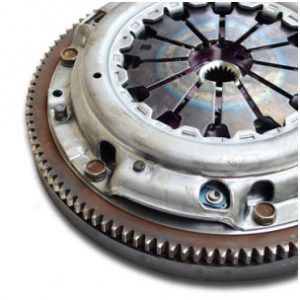
Driving a car with a manual transmission requires different steps, in sync, to change gears. You press the clutch, move the shift lever, and release the clutch slowly while increasing the throttle just to get the car to begin to move.
And every shift requires pressing the clutch and releasing the gas, while you hold the steering with one hand and shift the transmission with the other. Every limb must synchronize to drive the vehicle.
Components of Clutch Repair
Part of process involves your left foot pressing and releasing the clutch pedal. But exactly what is a clutch?
A clutch is a friction device that connects your car’s engine to the transmission. Pressing the clutch pedal releases the clutch, which separates the engine and transmission. This is what allows you to come to a stop without stalling the engine. It also makes shifting gears a lot easier.
The clutch consists of several separate components:
- A clutch disk — the friction device that makes the connection between the engine and transmission
- A flywheel — what give the clutch disk a surface to hold onto
- A pressure plate — the part that holds the clutch disk to the flywheel
- A throwout bearing — which presses the levers on the pressure plate when you press the clutch pedal to release the clutch
The technicians at Automotive Triage are very experienced with clutch service and replacement. They can check your car’s clutch and see whether the slip can be fixed with a simple adjustment or if you need a new clutch. And whatever they determine, they’ll be able to fix it for you at a reasonable price.
Transfer Case Repair
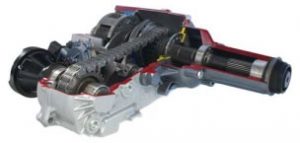
A problem with the transfer case can keep your vehicle from moving at all.
If you own a four-wheel drive vehicle, or something that requires a power output, such as a tow truck, you’re probably very familiar with what a transfer case is.
What is a Transfer Case?
For the rest of you, a transfer case mounts directly behind the transmission, to redirect torque from the transmission to other systems. In a four-wheel drive, the transfer case redirects torque to the front and rear axles, to allow all four wheels to drive the vehicle. On many vehicles, it’s the device that allows you to choose whether you are in two-wheel drive or four-wheel drive.
Whatever the use, a transfer case is an important part of many different types of vehicles. But since all the torque to the wheels has to run through the transfer case, a problem with the transfer case can appear very similar to a transmission failure: It can keep your vehicle from moving at all.
Expert Transfer Case Repair
Technicians at Automotive Triage are well versed in transfer case repair. They understand how those transfer cases operate and know how to diagnose and repair them to like-new operation.
And, most important, they know how to identify the root cause of your vehicle’s condition, to see whether it’s in the transmission or the transfer case.
Transmission Coolers
The number one enemy of automatic transmissions is heat. Nothing will destroy an automatic transmission faster than allowing it to overheat.
To help reduce that heat, nearly every automatic transmission has a transmission cooler, usually mounted in one of the radiator tanks.
Avoid an Overheated Transmission with Transmission Cooler Installation
Hot transmission fluid flows into the transmission cooler, where it’s surrounded by coolant. That heat is absorbed by the coolant, where it’ll eventually be released to the air passing over the radiator fins. The cooled transmission fluid then returns to the transmission to keep the transmission operating at a safe temperature.
On most cars, that factory cooler provides enough heat transfer to protect the transmission. But over time those coolers can plug or crush, restricting flow and reducing the amount of heat it can release.
On other vehicles, the load placed on the transmission ends up generating more heat than the factory cooler was designed to handle. Cars that pull campers or work trucks are common situations where the factory cooler just doesn’t provide adequate heat transfer to keep the transmission cool enough.
Auxiliary Transmission Coolers
In those situations, the answer is usually simple enough: add an auxiliary cooler to the system. These are generally small heat exchangers that replace the factory coolers. They usually mount in front of the radiator, and transfer heat from the transmission fluid directly to the ambient air passing over their fins. Our technicians can examine your car or truck, and let you know whether an auxiliary transmission cooler would be a worthwhile investment to help protect your automatic transmission.
ENGINE OVERHAULS & REPAIRS
Replace Your Engine or Have Your Old Engine Rebuilt?
The first step in replacing an engine is to confirm the old engine is beyond fixing or requires so much labor to repair that it is better to replace it. In some cases, engine replacement is a viable alternative to buying a new vehicle. It’s almost always less expensive to repair a car than buy a new one. Our trained professionals can help you make the decision to replace the engine on your old car or buy a new one. Many internal problems can be repaired without having to completely overhaul the engine, provided the rest of the engine is still in relatively good condition. Some of these other fixes include replacing a blown head gasket, a broken or rounded camshaft, a cracked piston, worn valve guides, burned or bent valves, a cracked head or even a spun bearing. However, if the block is cracked, can’t be repaired without major machine work or has to be completely disassembled, the cost of parts and labor may tip the scale in favor of replacing the engine.
After an in-depth assessment of your vehicle including year, make and model, AutomotiveTriage will provide you with pricing options: Replacing your current engine with a brand-new engine, a re-manufactured (i.e., rebuilt) engine, or a used engine from a reputable salvage yard. We provide you with corresponding warranty options depending on what engine you select. This will helpyou weigh the financial options available.
Timing Belt
A timing belt is a part of your car’s internal combustion engine. The belt synchronizes the camshaft and the crankshaft rotation so that the engine valves open and close at the correct timings. Also, the belt prevents the piston from striking the valves in an interference engine. Most cars we drive now have timing belts instead of timing chains and gears. Although different manufacturers have their recommended mileage, you need to have your car’s timing belt checked regularly.
Cylinder Block
A cylinder block is the powerhouse for the motor vehicle. The solid cast car part houses the cylinders and their components (gaskets, valves, and seals) inside a lubricated and cooled crankcase. Since it is one of the most important parts of your car, the block is designed to be extremely strong and sturdy. Although strong and sturdy, the block is susceptible to failure resulting in a vehicle that won’t start. Cracked blocks, porous blocks, core plug, or freeze plug failure are some of the problems facing cylinder blocks.
Cylinder Head
A cylinder head is the closed end of a cylinder (located in a car’s engine block). It sits above the cylinder block, closing the top of the cylinder and forming the combustion chamber. The cylinder head coordinates airflow in and out of the engine. Since the cylinder head’s chief function is to seal the cylinders properly, insufficient compression results in the car being difficult to drive.
FRAME REPLACEMENT
Frame Replacement
A vehicle frame, also known as its chassis, is the main supporting structure of a motor vehicle, to which all other components are attached, comparable to the skeleton of an organism.
Until the 1930s virtually every car had a structural frame, separate from its body. This construction design is known as body-on-frame. Over time, nearly all passenger cars have migrated to unibody construction, meaning their chassis and bodywork have been integrated into one another.
Nearly all trucks, buses, and most pickups continue to use a separate frame as their chassis.
Automotive Triage’s skilled technicians have the ability to swap out any frames on trucks and pickups that have a body-on-frame chassis. We specialize in supporting the Auto Body Collision industry where damaged frames are in need of replacement. Our techs swap over the engine, transmission, suspension, body and all electrical components. An OBDII Pre-Scan of the vehicles components are completed before the swap begins and a Post-Scan is performed after the swap to make sure all the systems are working and communicating properly. If any recalibration or reprogramming is required, Automotive Triage takes care of these things in-house.
AIR BAG AND RESTRAINT SERVICES
Lorem ipsum dolor sit amet, consectetur adipiscing elit, sed do eiusmod tempor incididunt ut labore et dolore magna aliqua. Ut enim ad minim veniam, quis nostrud exercitation ullamco laboris nisi ut aliquip ex ea commodo consequat.
ADAS SERVICES
Lorem ipsum dolor sit amet, consectetur adipiscing elit, sed do eiusmod tempor incididunt ut labore et dolore magna aliqua. Ut enim ad minim veniam, quis nostrud exercitation ullamco laboris nisi ut aliquip ex ea commodo consequat.
BATTERY SERVICES
Lorem ipsum dolor sit amet, consectetur adipiscing elit, sed do eiusmod tempor incididunt ut labore et dolore magna aliqua. Ut enim ad minim veniam, quis nostrud exercitation ullamco laboris nisi ut aliquip ex ea commodo consequat.
ADVANCED DIAGNOSTICS
Lorem ipsum dolor sit amet, consectetur adipiscing elit, sed do eiusmod tempor incididunt ut labore et dolore magna aliqua. Ut enim ad minim veniam, quis nostrud exercitation ullamco laboris nisi ut aliquip ex ea commodo consequat.
CARBURETOR SERVICES
Lorem ipsum dolor sit amet, consectetur adipiscing elit, sed do eiusmod tempor incididunt ut labore et dolore magna aliqua. Ut enim ad minim veniam, quis nostrud exercitation ullamco laboris nisi ut aliquip ex ea commodo consequat.
CHECK ENGINE LIGHT
Early Warning System
Modern vehicles are equipped with onboard computers that monitor the critical systems in your car and warn you when something is going wrong. Your check engine light is your vehicle computer’s way of telling you that there may be a problem and your car requires service as soon as possible.
So Many Possibilities
The reasons for a check engine light activation range from something as simple as a loose gas cap to something as serious as a faulty catalytic convertor. Below is a list of a few of the possible problems that could cause your check engine light to activate.
- Failing oxygen sensor
- A loose gas cap
- Bad spark plug/ignition coil
- Bad spark plug wires
- A problem with your catalytic converter
- Bad mass air flow sensor
- Engine vacuum leak
- EGR valve problem
- Excessive gas consumption or release of air pollutants
These are just a few of the hundreds of causes and symptoms that would result in an engaged check engine light. Decoding your dashboard is a science. The technicians at Automotive Triage are specialists in diagnosing the root cause of the check engine light.
Free Check Engine Light Diagnostics
Our Free Check Engine Light Code Retrieval Service provides you with quick and accurate answers from a professional technician. When the check engine light turns on, a fault code or OBD II code, detailing the nature of the issue is registered in your vehicle’s diagnostic system computer. This fault code is stored and can only be retrieved with specialized equipment that can communicate with your vehicle’s diagnostic system computer. We use that equipment to pull the code from your computer, analyze the findings and provide you with a game plan to get your car back on the road. The Check Engine Light Code Retrieval is free and our diagnostic services start as low as $80.
Do Not Ignore Your Vehicle
Do not panic – but don’t ignore that light – especially if it is flashing.
A solid glowing check engine light could be indicating a problem that is easily fixable. Your vehicle could require a simple adjustment or a replacement part. Driving long distances with this light activated could result in a larger problem down the road. It is safest for you and your passengers to learn what is going on with your vehicle sooner rather than later so that you can take the necessary measures to fix the issue.
CATALYTIC CONVERTERS
The catalytic converter is a key component of the exhaust system of a car. It changes some properties of the harmful gases produced as the byproduct running the engine. As a result, the emitted gasses make a less damaging impact on the environment. It’s important to know about the bad catalytic converter symptoms so that you can spot them immediately.
Automotive Triage technicians are experienced in diagnosing and replacing catalytic converters.
What Are Bad Catalytic Converter Symptoms?
A failing catalytic converter is not uncommon at all. The dreaded P0420 code is usually an indication that it has failed. Any external impact such as debris on the road or overheating of the engine’s internal components can affect it. Let’s see some of the symptoms of bad catalytic converter.
- Engine Misfiring
The catalytic converter can overheat and show signs of failing when the engine misfires. Also, you will see the similar signs when there is a very rich fuel mixture in the oil tank. Extremely rich fuel mixture causes ignition by making raw fuel entering the converter. The condition is dangerous since it can melt the catalyst components.
Misfiring of the engine could be a warning sign
- Loss of Power When Accelerating
Losing power during acceleration or going uphill is one of the most common clogged catalytic converter symptoms. Mechanics often misdiagnose this cause, especially in case of partial clogging, and suggest changing of a few components, which is unnecessary.
- Degraded Performance
An overall degradation in the engine performance is another sign. It happens because of the back pressure that the failing converter creates, affecting the engine and preventing it from running freely. It makes your car shake and the sudden burst of pressure can sometimes stall the engine too while you are driving.
- Reduced Exhaust System Performance
Another way to notice bad catalytic converter symptoms is to keep an eye on the exhaust system’s performance. It will degrade if the converter is failing and the problem can be traced back to an error in the fuel system.
The exhaust system will show degraded performance.
- Fuel Vapor
If your vehicle has a carburetor instead of fuel injection you can be sure of a poor catalytic converter if there is a cloud of vapored fuel over the carburetor. If this is the case, you can assume without a trace of doubt that your car’s catalytic converter has a clog.
- Increased Emissions
Increasing emissions is one of the bad catalytic converter symptoms you should notice. When a converter is failing, it can’t do its job properly, which is to reduce gaseous emission. So, a high level of carbon emission is the obvious consequence of a bad exhaust system. This is a serious problem as it can lead to the damage of the entire exhaust system if you don’t fix it quickly.
- Catalytic Converter Need Regular Maintained
Further small symptoms of a bad catalytic converter are: Reduced acceleration, sluggish engine performance, excessive heat under the vehicle, dark exhaust smoke, the smell of sulfur or rotten eggs from the exhaust. Some of those symptoms can also result from other defective parts of the emissions system, so it’s important to get a mechanic diagnose when it’s time to replace your catalytic converter. Keeping your exhaust, emissions and combustion systems in good shape will minimize the risk of your catalytic converter failing before its time to break down – often 10 years or more.
EXHAUST SERVICES
Lorem ipsum dolor sit amet, consectetur adipiscing elit, sed do eiusmod tempor incididunt ut labore et dolore magna aliqua. Ut enim ad minim veniam, quis nostrud exercitation ullamco laboris nisi ut aliquip ex ea commodo consequat.
ELECTRICAL REPAIRS
Lorem ipsum dolor sit amet, consectetur adipiscing elit, sed do eiusmod tempor incididunt ut labore et dolore magna aliqua. Ut enim ad minim veniam, quis nostrud exercitation ullamco laboris nisi ut aliquip ex ea commodo consequat.
SUSPENSION AND STEERING REPAIRS
Lorem ipsum dolor sit amet, consectetur adipiscing elit, sed do eiusmod tempor incididunt ut labore et dolore magna aliqua. Ut enim ad minim veniam, quis nostrud exercitation ullamco laboris nisi ut aliquip ex ea commodo consequat.
ECM PROGRAMMING
Lorem ipsum dolor sit amet, consectetur adipiscing elit, sed do eiusmod tempor incididunt ut labore et dolore magna aliqua. Ut enim ad minim veniam, quis nostrud exercitation ullamco laboris nisi ut aliquip ex ea commodo consequat.
COMPLETE SUSPENSION REPAIRS
Lorem ipsum dolor sit amet, consectetur adipiscing elit, sed do eiusmod tempor incididunt ut labore et dolore magna aliqua. Ut enim ad minim veniam, quis nostrud exercitation ullamco laboris nisi ut aliquip ex ea commodo consequat.
ADDITIONAL SERVICES
AUTO GLASS SERVICES
Lorem ipsum dolor sit amet, consectetur adipiscing elit, sed do eiusmod tempor incididunt ut labore et dolore magna aliqua. Ut enim ad minim veniam, quis nostrud exercitation ullamco laboris nisi ut aliquip ex ea commodo consequat.
TAPE STRIPES
Lorem ipsum dolor sit amet, consectetur adipiscing elit, sed do eiusmod tempor incididunt ut labore et dolore magna aliqua. Ut enim ad minim veniam, quis nostrud exercitation ullamco laboris nisi ut aliquip ex ea commodo consequat.
WINDOW TINTING
Lorem ipsum dolor sit amet, consectetur adipiscing elit, sed do eiusmod tempor incididunt ut labore et dolore magna aliqua. Ut enim ad minim veniam, quis nostrud exercitation ullamco laboris nisi ut aliquip ex ea commodo consequat.
WHEEL REPAIR
Lorem ipsum dolor sit amet, consectetur adipiscing elit, sed do eiusmod tempor incididunt ut labore et dolore magna aliqua. Ut enim ad minim veniam, quis nostrud exercitation ullamco laboris nisi ut aliquip ex ea commodo consequat.
HEADLIGHT CLEARING & RESTORATION
Lorem ipsum dolor sit amet, consectetur adipiscing elit, sed do eiusmod tempor incididunt ut labore et dolore magna aliqua. Ut enim ad minim veniam, quis nostrud exercitation ullamco laboris nisi ut aliquip ex ea commodo consequat.

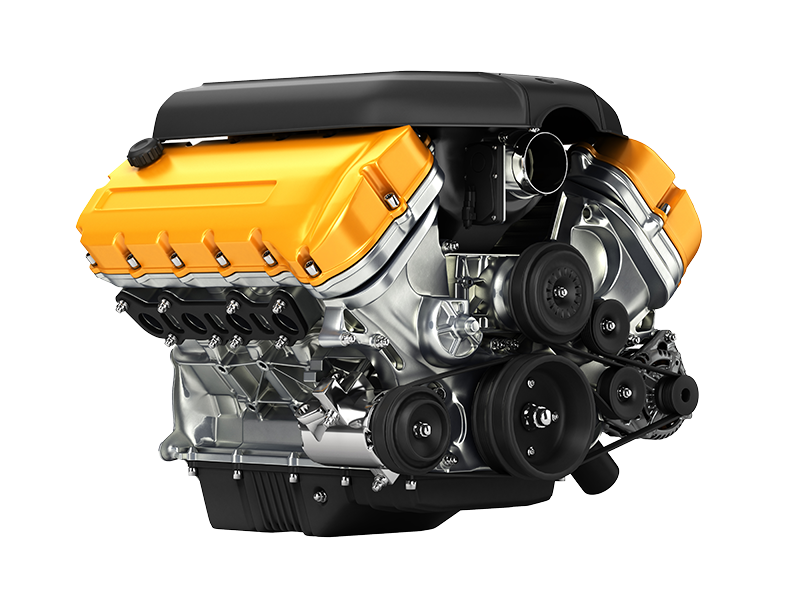
- Air conditioner/ heater repairs
- Batteries
- Brakes
- Carburetor specialists
- Catalytic Converters
- Computer specialists
- Domestic, Foreign & Diesels
- Electrical diagnostic and repairs
- Engine overhauls
- Exhaust and custom repair
- Injector service
- Mufflers
- New Car Maintenance
- Oil & Fluid Changes
- Shocks/ struts
- Suspension
- Tires
- Transmission work
- Tune-ups, major and minor
Air conditioner/ heater repairs
Batteries
Brakes
Carburetor specialists
Catalytic Converters
Computer specialists
Domestic, Foreign & Diesels
Electrical diagnostic and repairs
Engine overhauls
Exhaust and custom repair
Injector service
Mufflers
New Car Maintenance
Oil & Fluid Changes
Shocks/ struts
Suspension
Tires
Transmission work
Tune-ups, major and minor
